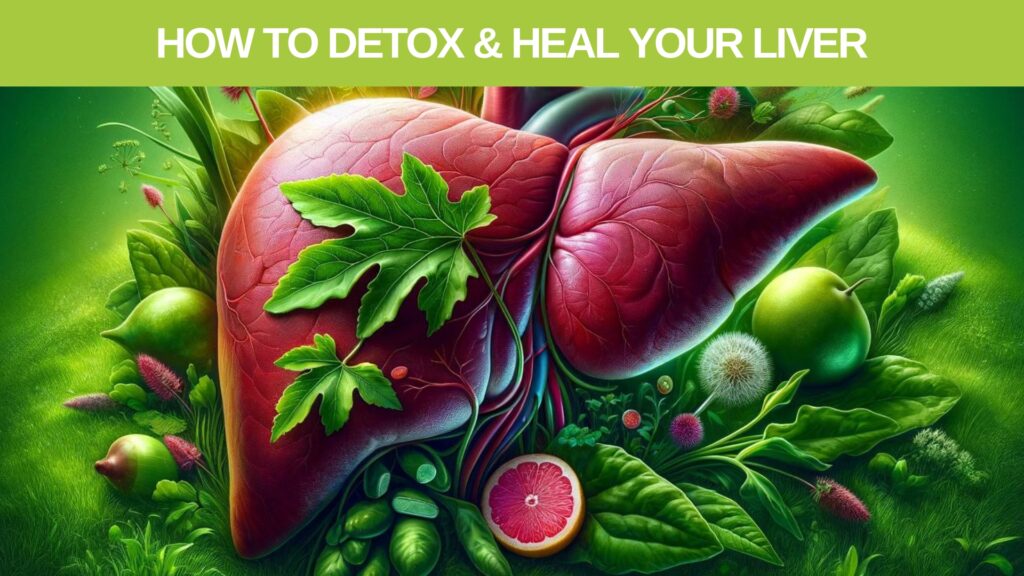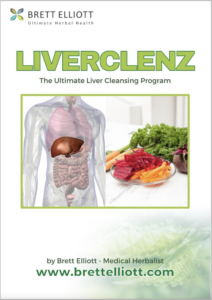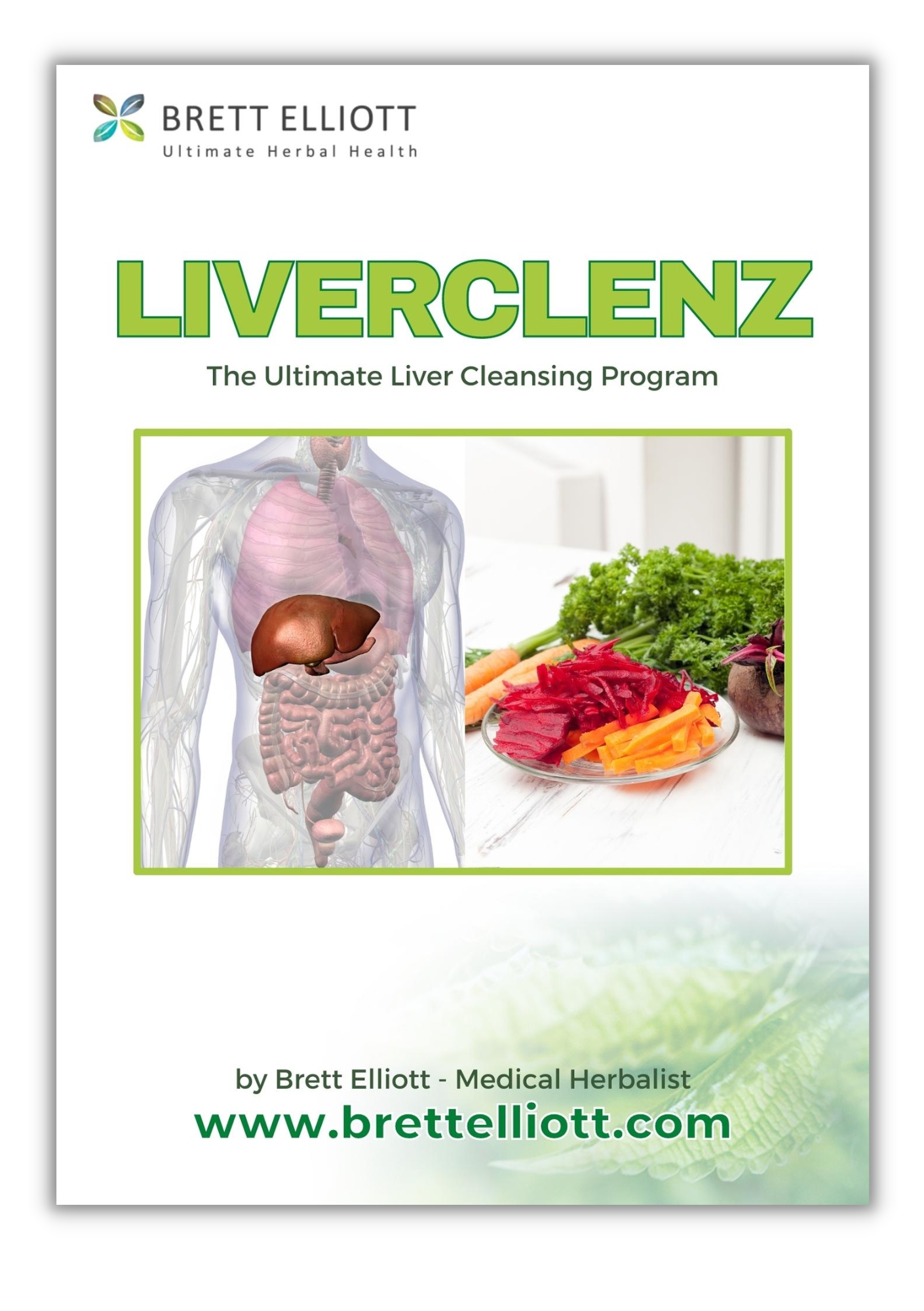- 3 weeks ago
- 29Minutes
- 6360Words
- 1772Views
How to Detox Your Liver Naturally
(1) A Review of Hepatoprotective Plants Used in Saudi Traditional Medicine PUBMED. http://www.ncbi.nlm.nih.gov/pmc/articles/PMC4281445/
(2) Georgiev V. G., Weber J., Kneschke E.-M., Denev P. N., Bley T., Pavlov A. I. Antioxidant activity and phenolic content of betalain extracts from intact plants and hairy root cultures of the red beetroot Beta vulgaris cv. Detroit Dark Red. Plant Foods for Human Nutrition. 2010;65(2):105–111. doi: 10.1007/s11130-010-0156-6. http://www.ncbi.nlm.nih.gov/pubmed/20195764
(3) Anti-nociceptive and anti-inflammatory effects of some Jordanian medicinal plant extracts. PUBMED http://www.ncbi.nlm.nih.gov/pubmed/9582001
(4) Chakole R., Zade S., Charde M. Antioxidant and anti-inflammatory activity of ethanolic extract of Beta vulgaris Linn. roots. International Journal of Biomedical and Advance Research. 2011;2(4):124–130.
(5) Carbon tetrachloride-induced hepatotoxicity: Protective effect of ‘Rocket’ Eruca sativa L. in rats. http://www.ncbi.nlm.nih.gov/pubmed/20128046
(6) Fermented barley extract supplementation maintained antioxidative defense suppressing lipopolysaccharide-induced inflammatory liver injury in rats. PUBMED http://www.ncbi.nlm.nih.gov/pubmed/21979071
(7) Unexpected paracetamol (acetaminophen) hepatotoxicity at a standard dosage in two older patients: time to rethink 1 g four times daily? PUBMED http://www.ncbi.nlm.nih.gov/pubmed/27103600
(8) Curcumin inhibits activation of TRPM2 channels in rat hepatocytes. PUBMED http://www.ncbi.nlm.nih.gov/pmc/articles/PMC4683391/
(9) Herbal antioxidant in clinical practice: A review. PUBMED http://www.ncbi.nlm.nih.gov/pmc/articles/PMC3819501/
(10) Hepatoprotective effects of berberine on carbon tetrachloride-induced acute hepatotoxicity in rats. http://www.ncbi.nlm.nih.gov/pmc/articles/PMC2949732/
(11) Protective effects of goldenseal (Hydrastis canadensis L.) on acetaminophen-induced hepatotoxicity through inhibition of CYP2E1 in rats. PUBMED http://www.ncbi.nlm.nih.gov/pmc/articles/PMC3249784/
(12) In vitro and in vivo hepatoprotective effects of the aqueous extract from Taraxacum officinale (dandelion) root against alcohol-induced oxidative stress. PubMed http://www.ncbi.nlm.nih.gov/pubmed/20347918
(13) Bitters: Time for a New Paradigm. PUBMED http://www.ncbi.nlm.nih.gov/pmc/articles/PMC4446506/
(14) Hepatotoxicity or Hepatoprotection? Pattern Recognition for the Paradoxical Effect of the Chinese Herb Rheum palmatum L. in Treating Rat Liver Injury. PUBMED http://www.ncbi.nlm.nih.gov/pmc/articles/PMC3167848/
(15) Rhein ameliorates fatty liver disease through negative energy balance, hepatic lipogenic regulation, and immunomodulation in diet-induced obese mice. PUBMED http://www.ncbi.nlm.nih.gov/pubmed/21364120/
(16) The kiwifruit peptide kissper displays anti-inflammatory and anti-oxidant effects in in-vitro and ex-vivo human intestinal models. PUBMED http://www.ncbi.nlm.nih.gov/pmc/articles/PMC3927908/
(17) Review of natural products with hepatoprotective effects. PUBMED http://www.ncbi.nlm.nih.gov/pmc/articles/PMC4209543/#B17
(18) Current Concepts of Mechanisms in Drug-Induced Hepatotoxicity PubMed: http://www.ncbi.nlm.nih.gov/pmc/articles/PMC2765083/
(19) Liver Regeneration. PUBMED https://www.ncbi.nlm.nih.gov/pmc/articles/PMC2701258/
(20) Non-alcoholic fatty liver disease (NAFLD) – pathogenesis, classification, and effect on drug metabolizing enzymes and transporters. PUBMED https://www.ncbi.nlm.nih.gov/pubmed/28303724
(21) Non-alcoholic fatty liver disease and its relationship with cardiovascular disease and other extrahepatic diseases. PUBMED https://www.ncbi.nlm.nih.gov/pubmed/28314735
(22) Nutritional Approaches to Achieve Weight Loss in Nonalcoholic Fatty Liver Disease. PUBMED https://www.ncbi.nlm.nih.gov/pubmed/28298270
(23) Epidemiology of non-alcoholic fatty liver disease. PUBMED https://www.ncbi.nlm.nih.gov/pubmed/20460905
(24) Traditional Chinese Medicine as a Basis for Treating Psychiatric Disorders: A Review of Theory with Illustrative Cases. PUBMED https://www.ncbi.nlm.nih.gov/pmc/articles/PMC3870484/#B21
(25) Depression, Constraint, and the Liver: (Dis)assembling the Treatment of Emotion-Related Disorders in Chinese Medicine. PUBMED https://www.ncbi.nlm.nih.gov/pmc/articles/PMC3586067/
(26) The Effect of Artichoke Leaf Extracts on Alanine Aminotransferase and Aspartate Aminotransferase in the Patients with Nonalcoholic Steatohepatitis. PUBMED https://www.ncbi.nlm.nih.gov/pmc/articles/PMC4879230/
(27) New Perspectives on How to Discover Drugs from Herbal Medicines: CAM’s Outstanding Contribution to Modern Therapeutics. PUBMED https://www.ncbi.nlm.nih.gov/pmc/articles/PMC3619623/
(28) Attenuation of Carcinogenesis and the Mechanism Underlying by the Influence of Indole-3-carbinol and Its Metabolite 3,3′-Diindolylmethane: A Therapeutic Marvel. https://www.ncbi.nlm.nih.gov/pmc/articles/PMC4060499/
(29) Sinigrin and Its Therapeutic Benefits. https://www.ncbi.nlm.nih.gov/pmc/articles/PMC6273501/
(30) Antioxidant dietary approach in treatment of fatty liver: New insights and updates. https://www.ncbi.nlm.nih.gov/pmc/articles/PMC5483489/
(31) Plants Consumption and Liver Health. https://www.ncbi.nlm.nih.gov/pmc/articles/PMC4499388/
(32) Acetaminophen-Induced Hepatotoxicity: a Comprehensive Update. PUBMED https://www.ncbi.nlm.nih.gov/pmc/articles/PMC4913076/
(33) Toxic hepatitis in occupational exposure to solvents. PUBMED https://www.ncbi.nlm.nih.gov/pmc/articles/PMC3374978/
(34) Industrial, biocide and cosmetic chemical inducers of cholestasis. PUBMED https://www.ncbi.nlm.nih.gov/pmc/articles/PMC7176485/
(35) Fructose and Sugar: A Major Mediator of Nonalcoholic Fatty Liver Disease. PUBMED https://www.ncbi.nlm.nih.gov/pmc/articles/PMC5893377/
(36) Effect of Microalgae and Macroalgae Extracts on Non-Alcoholic Fatty Liver Disease. PUBMED https://www.ncbi.nlm.nih.gov/pmc/articles/PMC8230871/
(37) Peripheral neuropathy in liver cirrhosis. PUBMED https://pubmed.ncbi.nlm.nih.gov/12859721/
Let’s talk about your Liver function!
Liver Detox is a controversial subject because medical doctors generally say “you can’t detox your liver because your Liver detoxifies itself”
This John Hopkins article is a classic example
This is true in a sense, but what we often fail to understand is that the Liver can become overloaded and poisoned with the very toxins it’s meant to process and start to break down, become diseased and even fail completely.
On this page we are going to cover these five major areas:
- Ten Early Signs Of Liver Dysfunction
- What You Didn’t Know About Liver Function
- Is Liver Toxicity Real & The Impact of Lifestyle Choices
- Foods and Herbs To Detox and Cleanse Your Liver
- Understanding Liver Energy for Healing
Click the headings above to skip to each topic.
This short video summarizes things very well, but you might need to pause it in places if you want to read the research snippets.
TOP 10 Signs and Symptoms of Liver Dysfunction
Early-stage liver dysfunction often manifests subtly and can be overlooked easily. Here’s a list of common signs and symptoms that might indicate mild liver disease or dysfunction:
Fatigue and General Weakness: One of the most common and often overlooked symptoms of liver dysfunction.
Mild Jaundice: A slight yellowing of the skin and the whites of the eyes, indicating a buildup of bilirubin.
Abdominal Pain and Bloating: Especially in the upper right part of the abdomen, which may indicate liver swelling.
Itchy Skin: Persistent itching without an apparent cause can be a sign of liver disease due to bile salts deposited in the skin.
Pale Stools and Dark Urine: Changes in stool color to a clay-like appearance and darkening of urine can signal liver issues.
Loss of Appetite: Often accompanied by mild nausea or aversions to certain foods, particularly fatty foods.
Nausea or Vomiting: This can occasionally occur, especially after eating fatty meals, due to impaired bile production.
Swelling in Legs and Ankles: Fluid retention, known as edema, can occur due to the liver’s reduced ability to produce albumin.
Unexplained Weight Loss: Significant weight loss without trying might be a sign of liver disease.
Easy Bruising or Bleeding: The liver’s impaired ability to produce clotting proteins can lead to more frequent bruising or bleeding.
Detox supplements that address the entire digestive system indirectly support the Liver.
By clearing undigested, built-up matter from the colon, a Ultimate Herbal Detox program with a high dose of herbs will reduce the amount of re-circulating waste substances straining the Liver.
Our Ultimate Herbal Detox program has a specific range of herbs designed to specifically detox your Liver.
Liver disease is one of the major causes of morbidity and mortality across the world. According to the World Health Organization estimates, about 500 million people are living with chronic hepatitis infections resulting in the death of over one million people annually.
Medicinal plants serve as a vital source of potentially useful new compounds for the development of effective therapy to combat Liver problems. (1)
What does your Liver do?
Weighing in at 1.5 kilos your Liver is the largest organ of your body. It is like a busy chemical-processing factory that performs over 500 functions for the body. The healthy functioning of your Liver is vital to the continued life of your physical body.
The Liver is responsible for over 250 functions including:
Breaking down and eliminating every toxic substance that enters your bloodstream: The liver acts as the body’s primary detoxification center. It metabolizes and neutralizes toxins, such as alcohol, drugs, and environmental pollutants, rendering them harmless or preparing them for excretion via bile or urine.
Processing and sorting all the blood and nutrients returning from the digestive process: After food is digested, nutrients are absorbed into the bloodstream and transported to the liver via the portal vein. Here, the liver filters and processes these nutrients, ensuring they are distributed appropriately to the body’s cells for energy, growth, and repair.
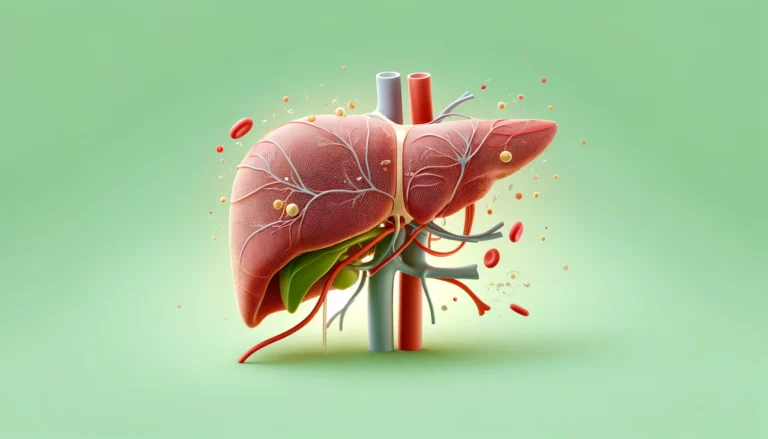
Producing bile for digestion: Bile, synthesized by the liver, aids in the digestion and absorption of fats in the small intestine. It emulsifies fats, breaking them down into smaller particles that can be more easily digested and absorbed by the body.
- Balancing cholesterol: The liver regulates cholesterol levels by producing and releasing cholesterol into the bloodstream as needed. It also removes excess cholesterol from the blood, helping to maintain optimal levels and support overall cardiovascular health.
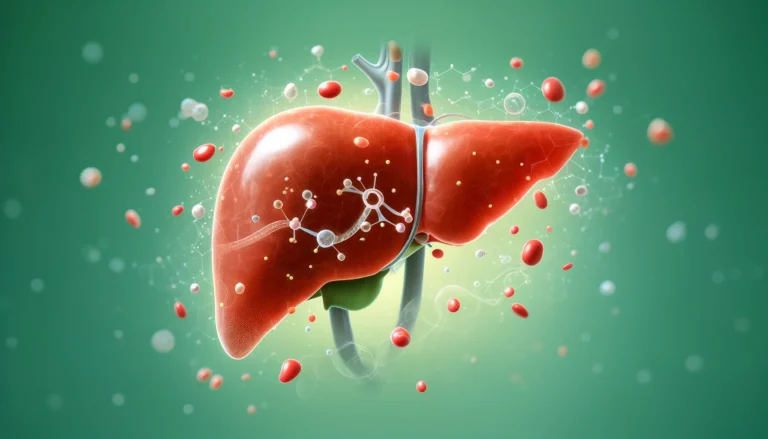
Balancing your hormones as the body’s largest Endocrine gland: As an endocrine gland, the liver plays a crucial role in hormone regulation. It metabolizes and clears hormones from the bloodstream, ensuring proper hormonal balance. Additionally, the liver produces important proteins involved in hormone transport and signaling.
Storage of some nutrients ready for the body to use: The liver serves as a storage depot for essential nutrients, including vitamins (such as vitamins A, D, E, and K) and minerals (such as iron and copper). These stored nutrients can be released into the bloodstream as needed to support various bodily functions.
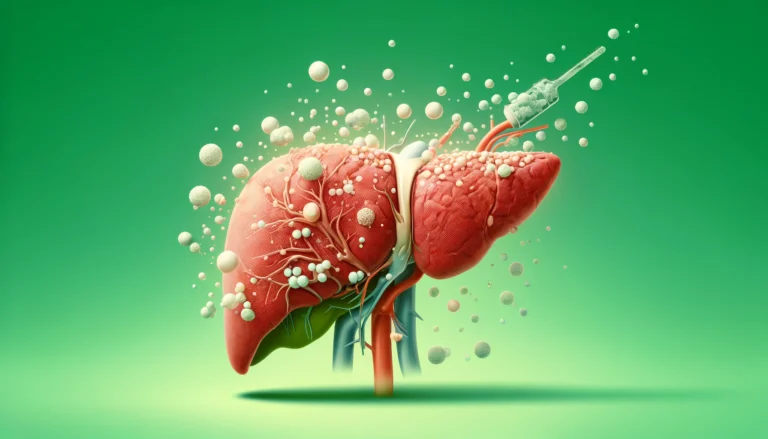
Many metabolic processes, such as blood fluid and blood sugar balance: The liver is involved in numerous metabolic processes essential for maintaining homeostasis. It helps regulate blood glucose levels by storing excess glucose as glycogen and releasing it when blood sugar levels drop. Additionally, the liver synthesizes and regulates proteins and enzymes involved in blood clotting, immune function, and nutrient metabolism.
Synthesizing substances essential for the immune system: The liver produces proteins, such as albumin and globulins, which play critical roles in immune function. These proteins help transport nutrients, hormones, and waste products in the bloodstream and contribute to the body’s defense against infections and diseases.
The list goes on and truly testifies to the benefits of maintaining a healthy Liver. The power of your Liver to regenerate is incredible. Even after 2/3 of a human Liver is removed it can grow back very quickly. Normal liver weight is reestablished within 8–15 days in humans. (19)
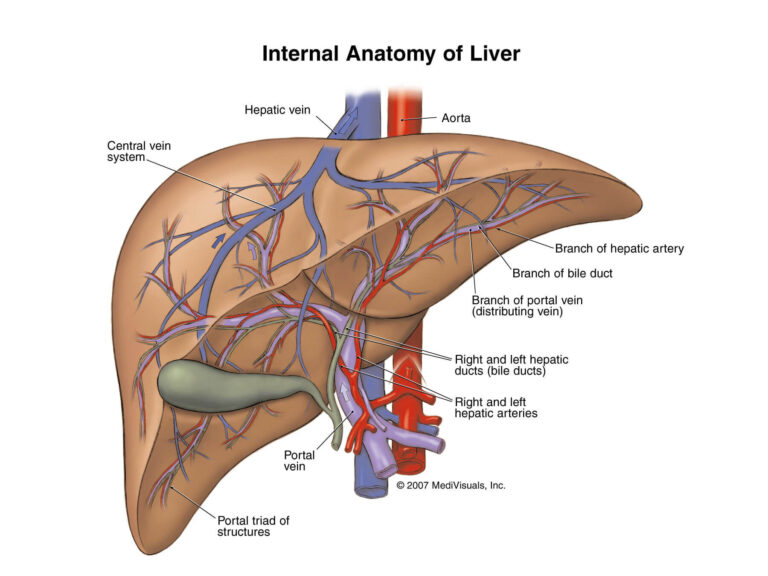
Benefits of a Healthy Liver
Your Liver has to absorb almost 100% of what goes into your body via the mouth and digestive tract, as the majority of blood enters the liver from the Portal vein, directly from the gut.
There is much you can do to improve your health, simply by giving a little TLC to your Liver.
If you have high cholesterol, then rather than taking a harmful statin drug, nurture your Liver!
For a sluggish bowel, acne, poor immune system, bloating, or menopause supporting Liver function is key.
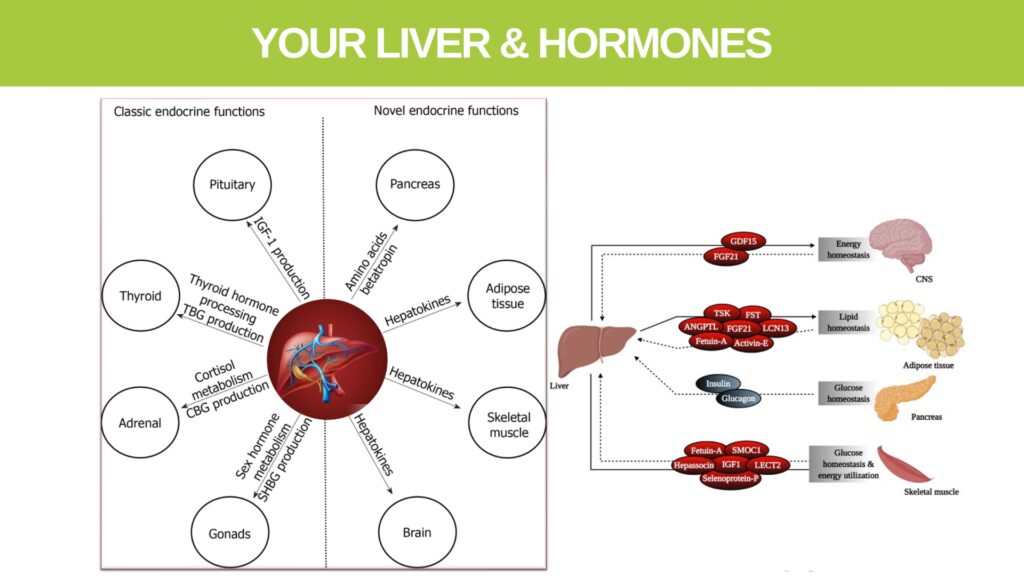
The Liver & Endocrine System
The liver, which is the largest solid organ in the body, plays a critical role in our endocrine system—essentially the body’s hormone headquarters. It not only produces and releases hormones but also processes them and their binding proteins, managing everything from vitamin D and growth factors to glucose and lipid (fat) levels. Over the past decade, research has uncovered many new roles of the liver in this system, revealing complex interactions that impact conditions like osteoporosis, diabetes, and weight management.
Here are some key points about the liver’s endocrine functions:
- Hormone Production and Metabolism: The liver produces vital substances like insulin-like growth factors and helps in the metabolism of hormones including thyroid hormones and glucocorticoids.
- Regulation of Metabolic Fuels: It plays a significant role in managing the body’s fuel sources, affecting how we use and store fats and sugars.
- Impact on Health Conditions: Dysfunction in liver-related endocrine activities can lead to serious health issues such as vitamin D deficiency, bone density loss, and changes in body weight.
- Emerging Research: Recent studies have introduced new liver hormones such as betatrophin and fetuin-A, which have been found to influence insulin sensitivity and lipid metabolism. The field is rapidly evolving, with ongoing discoveries that promise to deepen our understanding of how the liver affects overall health.
This expanding knowledge underscores the liver’s crucial role in balancing our body’s metabolic processes and hints at future breakthroughs in understanding and treating various metabolic diseases.
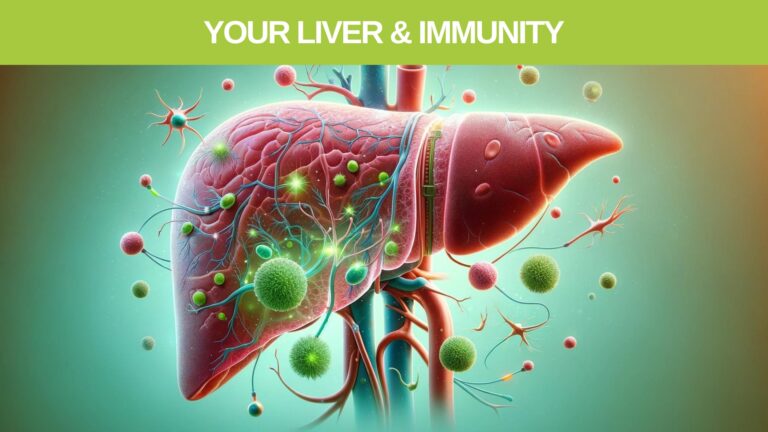
The Liver & Immune System?
The human liver plays a crucial role in the immune system due to its strategic location and the diversity of functions it performs. Here’s a brief overview of how the liver is involved in immune system functioning:
Immune Surveillance: The liver contains a large number of immune cells, known as Kupffer cells, which are specialized macrophages residing in the liver. These cells play a key role in filtering blood, capturing and digesting bacteria, fungi, parasites, worn-out blood cells, and cellular debris.
Production of Immune Proteins: The liver produces various proteins that are vital for the immune response, including acute phase proteins like C-reactive protein (CRP), which increase in response to inflammation. It also produces complement proteins that help in enhancing the ability of antibodies and phagocytic cells to clear pathogens from an organism.
- Liver and Innate Immunity: The liver is a central immunological organ that detects and responds to circulating antigens, utilizing its large complement of immune cells, including Kupffer cells. These cells help to maintain immune homeostasis and prevent overactivation, which could lead to tissue damage.
Let’s say you eat a healthy balanced diet with only occasional alcohol but suffer from frequent chest infections, headaches, or skin irritations. Nothing to do with your Liver you think, until you connect the dots above.
You stay up too late at night and then perhaps wake in the middle of the night. This is the time your Liver is the most active, dumping toxins and producing immune components such as natural killer cells.
However, an active liver requires you to be resting at this particular time so it can get to work. If you wake during the nights sweating or feeling uncomfortable, tossing and turning, or getting hot feet then these are signs pointing to a disturbed Liver function.
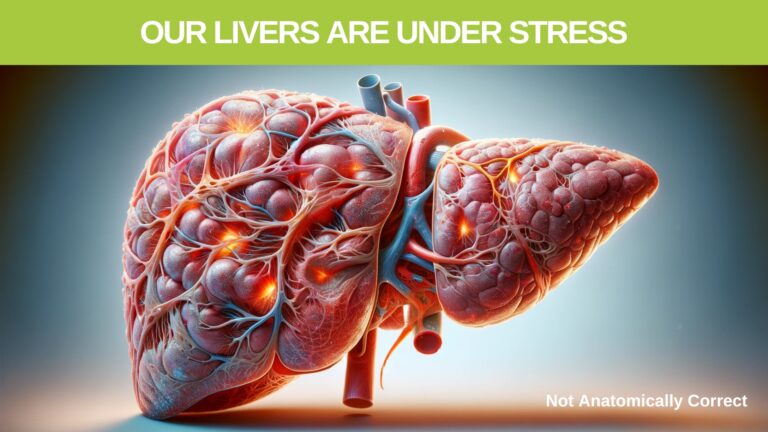
Prevalence of Liver Disease
Hepatitis B: Globally, an estimated 296 million people were living with chronic hepatitis B infection in 2019. This disease can lead to severe liver scarring (cirrhosis) and liver cancer. (World Health Organization)
Hepatitis C: Approximately 58 million people worldwide have chronic hepatitis C, a major cause of liver cirrhosis and liver cancer. (World Health Organization)
Alcoholic liver disease: This disease affects about 3% of the global population. It is caused by excessive alcohol consumption and can lead to cirrhosis and liver failure. (National Institute on Alcohol Abuse and Alcoholism)
Non-alcoholic fatty liver disease (NAFLD): NAFLD affects approximately 25% of the global population. It is linked to obesity, diabetes, and high cholesterol, and can progress to non-alcoholic steatohepatitis (NASH), cirrhosis, or liver cancer. (Clinical and Molecular Hepatology)
Cirrhosis: Globally, cirrhosis causes more than 1 million deaths per year. It is often the end-stage of many chronic liver diseases, such as hepatitis C and alcoholic liver disease. (The Lancet)
Liver cancer: Liver cancer, primarily hepatocellular carcinoma, is the fourth most common cause of cancer death worldwide, with hepatitis B and C as leading risk factors. (World Health Organization)
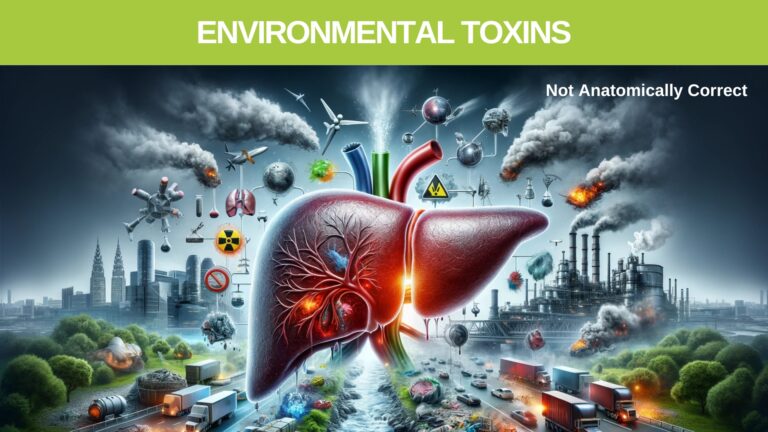
Environmental and Industrial Liver Toxins (HepatoToxins)
What are Hepatotoxins?
Studies have suggested that exposure to organic solvents such as dimethylformamide and trichloroethylene may induce liver toxicity, but it’s no surprise, the list of liver toxins is far bigger. (33)
These liver toxic chemicals are called Hepatotoxins!
Because most chemicals are metabolized in the liver, and it’s actually the toxic metabolites generated through the metabolism that are the main cause of liver damage.
Work activities with hepatotoxin exposure are numerous and include chemists, dry cleaners, farm workers, painters, health care workers, nurses, and printers, but there also many domestic hepatotoxins.
Let’s explore the most common of these.
Organic solvents
These are used in various industrial processes such as:
Industrial Sources:
- Paint Thinners and Strippers used in manufacturing and body shops.
- Degreasers are common in mechanical and industrial cleaning processes.
- Adhesives used in furniture making and construction.
- Dry Cleaning Solutions employed in the textile and garment care industries.
- Aeronautical and auto manufacturing and maintenance
- Metal production and processing Chemical storage facilities.
Domestic Sources:
- Household Cleaners such as those for carpets and upholstery.
- Nail Polish Remover contains acetone, an organic solvent.
- Paints and Varnishes used in home decoration.
- Automotive Products such as antifreeze and brake cleaners.
- Pesticides and Fungicides
Major Contamination Pathways
- Ingestion of water,
- Skin absorption via water baths
- Inhalation of of solvents, and heated bathrooms with a shower. (33)
Main Pathogenic Mechanisms
These are responsible for functional and organic damage caused by solvents are:
- Inflammation,
- Dysfunction of cytochrome P450,
- Mitochondrial dysfunction
- Oxidative stress. (33)
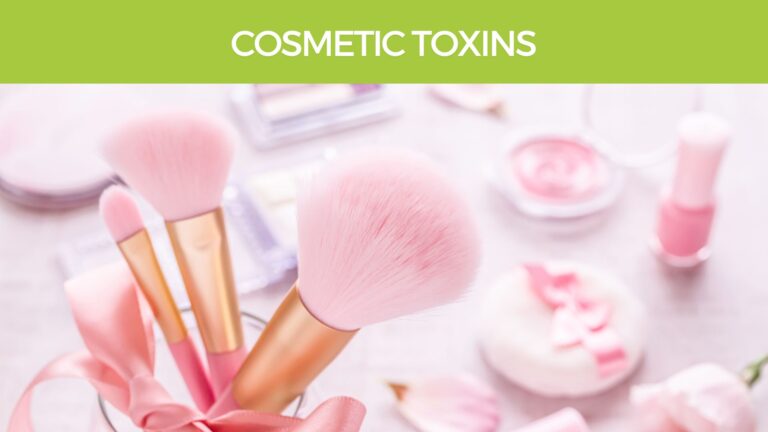
Cosmetics and Liver Function
Over recent decades, several compounds from a broad chemical space and diverse application areas have been found to induce unexpected and/or unpredicted cholestatic (Liver stagnation) effects, presenting similar to jaundice. (34)
Liver Toxins In Cosmetics
- Tartrazine is an orange-colored dye
- Sunset Yellow FCF is a cosmetic, drug, and food dye that has been linked to primary biliary cholangitis, occurring most frequently in postmenopausal women.
- Basic Red 51 is an oxidative and semi-permanent hair dye. (34)
- Triclosan contained in soaps and toothpastes, as well as in cleaning agent and detergents
- 2-Octynoic acid and 2-nonynoic acid are widely used in perfumes, soaps, detergents, lipsticks, toilet waters, facial creams, and other perfumed cosmetics
The Hidden Danger of Pharmaceuticals To Liver Health
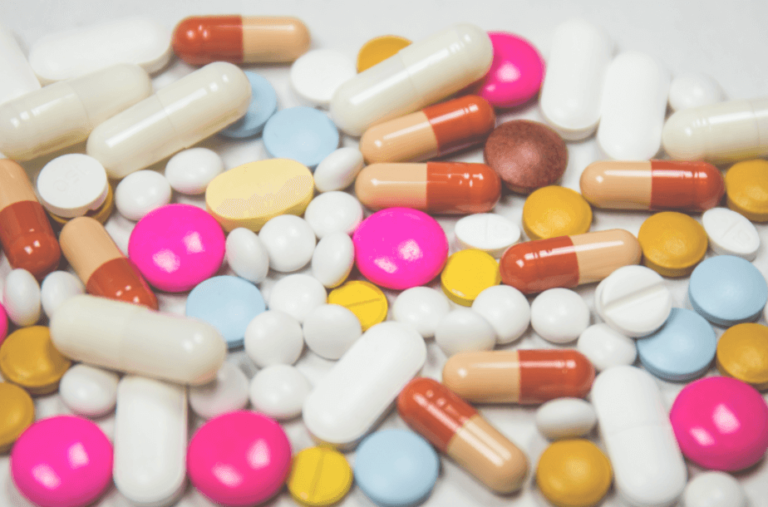
Many substances including medicinal drugs commonly thought to be safe are bombarding the Liver with the extra workload, acidity, inflammation, and tissue damage. For example, thousands of people around the world think nothing of taking painkillers on a regular basis yet acetaminophen (paracetamol) toxicity is common. It is so dangerous it can completely destroy Liver function if taken only slightly above the dose stated on the label. Known by various names in different countries this is paracetamol, (7)
Tylenol, and other over-the-counter cold and flu, fever, and pain remedies. Experience shows that even when prescribed appropriately at the usual therapeutic dosage, paracetamol can be toxic to the Liver (hepatotoxic). (7)
In fact Mortality rates from Paracetamol-induced liver failure have been approximated at 0.4% in overdose patients, translating to 300 deaths annually in the United States. Although toxic ingestions causing hepatic failure are usually in excess of 150 mg/kg, an increasing number of reports have arisen to suggest that lower doses of APAP may confer acute liver injury and liver failure. A so-called “therapeutic misadventure” phenomenon, as coined by Zimmerman et al., is becoming increasingly acknowledged, as some patients have presented with acute liver failure despite consumption of “safe” doses of Paracetamol.
Drug-induced liver injury (DILI) has become a leading cause of severe Liver disease in Western countries and therefore poses a major clinical and regulatory challenge. (18) According to recent reports, oxidative stress plays a pivotal role in the initiation and progression of hepatic damage following an insult to a variety of hepatotoxins. The role of oxidative stress in viral hepatitis and autoimmune-related Liver diseases has been extensively documented. Moreover hepatotoxic chemicals damage liver cells. (1)
The Liver is the largest and most vital organ of the human body. Besides its crucial role in the metabolism of nutrients, the Liver is responsible for the biotransformation of drugs and chemicals thereby protecting the body against toxic foreign materials. In this process, the Liver is exposed to a high concentration of toxic chemicals and their metabolites which may cause Liver injury.
There are more than a hundred well-known Liver diseases with diversified pathology. The most frequent causes of hepatic disease include infectious agents (especially hepatitis viral A, B, and C), obesity-related fatty Liver disease, xenobiotics (alcohol, drugs, and chemicals) induced Liver injury, inherited and genetic defects related to Liver diseases, autoimmune hepatitis, liver cirrhosis, and primary or secondary Liver cancer. (1) So what can we do to detoxify and heal our Liver? You are about to find a world of answers.
What about Fatty Liver Disease?
You’ve probably heard the term fatty liver, as it has become very common but what exactly is it?
Non-alcoholic fatty Liver disease (NAFLD) is a spectrum of liver disorders. It is defined by the presence of steatosis (stagnant fat) in more than 5% of liver cells with little or no alcohol consumption involved. Insulin resistance, metabolic syndrome, or type 2 diabetes seem to play a role in the onset of NAFLD. (20) NAFLD is rapidly becoming the most common Liver disease worldwide. The prevalence of NAFLD in the general population of Western countries is 20-30%. About 2-3% of the general population is estimated to have non-alcoholic steatohepatitis (NASH) which may progress to liver cirrhosis and hepatocarcinoma.
As a rule, the prevalence of NAFLD is higher in males and increases with increasing age and it is influenced by the diagnostic method and the characteristics of the population, especially lifestyle habits. (23) Key physiological functions of the Liver, including glucose and lipid metabolism, become disturbed in the setting of NAFLD. Consequently, the effects of NAFLD extend beyond the Liver with a large body of clinical evidence demonstrating NAFLD to be associated with both cardiovascular disease and chronic kidney disease. (21)
Weight loss is the cornerstone treatment for NAFLD. Various randomized controlled trials have shown that weight loss of 5-10% leads to significant improvements in hepatic steatosis. (22)
Sugar and Fatty Liver
Clinical studies suggest that reducing sugary beverages and total fructose intake, especially from added sugars, may have a significant benefit in reducing hepatic fat accumulation. (35)
We will outline below, herbs and foods which reduce fatty Liver as part of the Liver detox program.
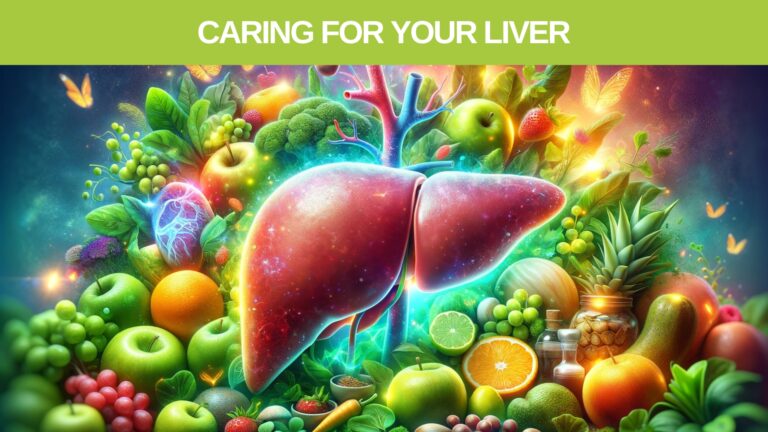
Liver protection made easy
We can see that healthy Liver function is necessary every time you eat a meal, come into contact with pesticides, pass through menopause, take a painkiller, and every second of the day. The good news is that there is much you can do to aid your Liver. First, there are the obvious lifestyle necessities:
- Adequate sleep….at night
- A balanced diet high in live, unprocessed fruits and vegetables (packet foods made in the factory are not it!)
- Moderate, regular exercise, is necessary for circulation to the liver and health of organs, muscles, blood vessels, to lighten the load on the Liver
- Drink adequate water, it is your body’s solvent that helps your blood carry nutrients and wastes in and away from the Liver
- Avoid alcohol, processed foods with lots of additives
- Avoid taking pharmaceutical drugs if at all possible and seek out natural medicines where practical
Let’s take a look at some of the more specific choices which have a direct effect on the Liver. Specific foods and food supplements, herbs, and detox programs.
Liver Cleansing Diet
- Brassica: Broccoli, Cauliflower, Kale, Cabbage, Brussels sprouts – and the rest of the brassica family of vegetables are proven to support Phase 2 Liver detoxification, eat plenty of broccoli, cauliflower, cabbage (all kinds), and kale. In fact, rocket was observed to protect the Liver against induced hepatic injury through its potent antioxidant activity. (5)Cruciferous vegetables contain a substance called Indole-3-carbinol (I3C). Both the Phase I and Phase II detoxification centers in the liver and the cells of the intestines can be accelerated by I3C. Many researchers indicate that the ability of cruciferous vegetables to motivate Phase I and Phase II detoxification, particularly their I3C content, is a primary factor in how these foods reduce cancer risk in humans. (28)
- Wasabi, Horseradish, and Mustard – These condiment foods contain a compound called Sinigrin which is also found in smaller amounts in other members of the Brassica family of vegetables. Sinigrin has been shown to combat liver cancer, and findings indicated that the liver functions were gradually restored after treatment with Sinigrin. (29, 30)
- Raw fermented vegetables (see recipe) – give increased nutrients and support the health of the microbiome which in turn aids the Liver function. Some studies suggest that the consumption of fermented foods can influence bile acid metabolism, which in turn supports liver function and fat digestion. Incorporating raw fermented vegetables such as sauerkraut, kimchi, and pickles into your diet could therefore support liver health in multiple ways.
- Onions – Food plants in the Allium genus include different chives, garlic, leeks, onions, and scallions. They present various flavors and mouthfeels and are consumed either cooked or raw all over the world in different delicacies. A number of studies both in vitro and in vivo have been published reporting that allium-genus plants have potent hepatoprotective activity and distinct effects on various liver conditions such as hypercholesterolemia-induced oxidative stress, cadmium liver accumulation, liver fibrosis, liver fluke, and alcoholic fatty liver. (31)
- Beetroot – for blood building (the Liver contains 13% of your body’s blood); beetroot (Beta vulgaris) is high in iron, is a good antioxidant, and has been shown to protect liver cells. The hepatoprotective activity of Beta vulgaris may be attributed to its antioxidant (2) and anti-inflammatory (3) activities. The plant is safe to use even in large doses. Phytochemical studies on roots of Beta vulgaris have shown the presence of betaine, betacyanins, betaxanthins, oxalic acid, and ascorbic acid (4)
- Turmeric – a common spice you can add to soups, casseroles, curries, and rice. Turmeric protects the liver against oxidative stress, improves blood circulation, and improves liver function and detoxification processes. It has been shown that curcumin is very effective in preventing Liver damage induced by paracetamol overdose and that the level of protection afforded by curcumin against paracetamol-induced liver damage is comparable to that of N-acetyl cysteine (NAC), which is presently the main clinical treatment for paracetamol overdose in humans. (8)
- Grapefruit – Studies conducted over past decades have suggested that the grapefruit might be active in cellular regeneration, cholesterol reduction, the detoxifying process, and the maintenance of heart health, in rheumatoid arthritis, for the control of body weight, and in cancer prevention. Grapefruit juice is an excellent source of many phytochemicals and nutrients that contribute to a healthy diet. Naringin: This is the most abundant flavonoid in grapefruit juice. It’s responsible for the fruit’s characteristic bitter taste. It reduces fat accumulation in the Liver and increases Liver enzymes involved in detoxification. (17)
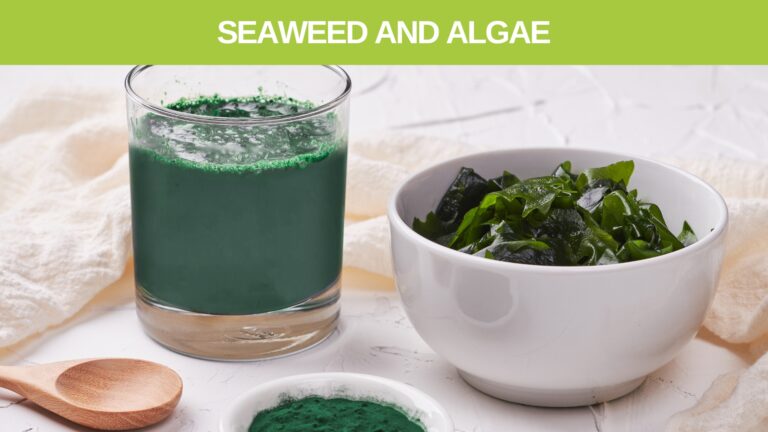
- Seaweeds and Algae – There is scientific evidence supporting the beneficial effects of microalgae and the different types of macroalgae (green, red and brown) on liver steatosis in rodent models. They are rich in a great number of bioactive compounds, such as peptides, pigments, phenolic compounds and fatty acids with potential applications in health, due to their antioxidant, antimicrobial, anti-inflammatory, anticancer, antidiabetic, antihypertensive, antihiperlipidaemic and antiobesity effects. (36)
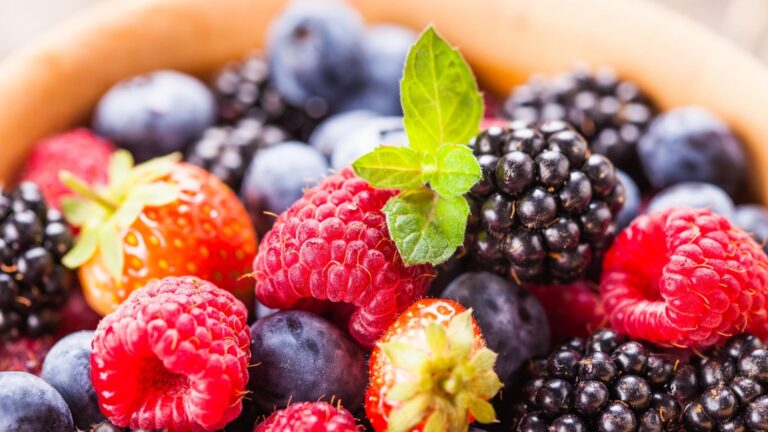
- Berries – These include Blueberries (Bilberry), Cranberry, and Grape due to anthocyanins and proanthocyanidins. The results of one study indicated that treatment with Blueberry significantly increased the liver enzymes, and spleen function, improving the proliferation of lymphocytes deriving from this organ. In conclusion, the authors suggested that consuming this berry type protected Liver hepatocytes from Oxidative Stress and could modulate the function of T cells. It is important to remember that anthocyanins and proanthocyanidins are widely available compounds in fruits, vegetables, and seeds of natural origin. (17)
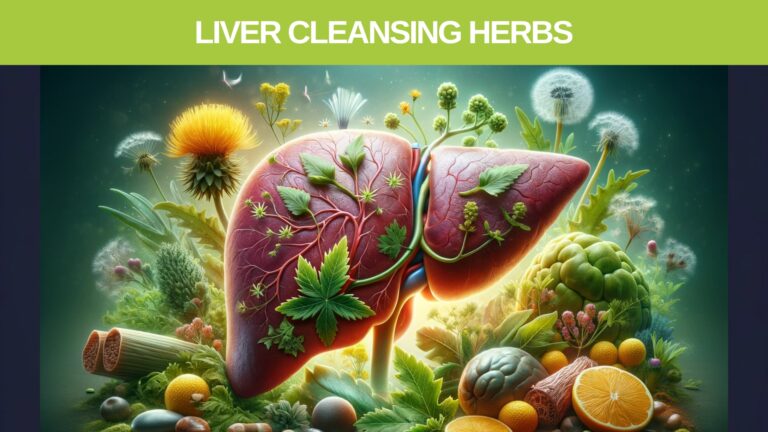
Herbs For Cleansing The Liver
Herbal medicines have a long history of treating liver complaints, protecting the liver from damage, and encouraging healthy liver function.
These Herbs discussed can all be found in the Herbal Detox Program Below

- Chamomile: Results have confirmed that the chamomile extract has reversal effects on the levels of paracetamol hepatotoxicity, and the authors concluded that the extract served as a hepatoprotective agent and that this hepatoprotective activity of chamomile might be due to the normalization of impaired membrane function activity. (17)
- Milk thistle: The seeds are well known for their Liver protection properties. Milk Thistle helps repair damaged Liver tissue and aids in Liver detoxification. A well-known hepatic antioxidant, silymarin, from the milk thistle (Silybum marianum), inhibits Liver damage by scavenging free radicals among other mechanisms. This powerful antioxidant protects the Liver against alcohol and pharmaceutical injury and even poisoning from extremely toxic compounds. (9)Milk Thistle is one of the most investigated plant extracts, with known mechanisms of action for oral treatment of toxic liver damage. Silymarin has been used as a protective treatment in acute and chronic liver diseases. (17) It also acts by stimulating Liver cell regeneration and cell membrane stabilization to prevent hepatotoxic agents from entering hepatocytes (17)
- Globe Artichoke: Based on recent basic and clinical investigations, the extract of artichoke (Cynara scolymus) leaf has been revealed to be used for hepatoprotective and cholesterol-reducing purposes. The study sheds light on the potential role of Cynara scolymus in the management of Non-Alcoholic Steatohepatitis. The active constituents of this herb such as flavonoids and caffeoylquinic acid may be responsible for this effect. These compounds have been proven to have hepatoprotective activity and hypolipidemic effects. (26)
- Goldenseal: The root contains substances that protect the Liver, aid Liver function, and are antimicrobial. Another great Liver stimulant and protector. One study demonstrated that berberine (from Golden Seal) possesses hepatoprotective effects against Liver toxicity and that the effects are both preventive and curative. Berberine should have the potential for developing a new drug to treat Liver toxicity. Results of another study show that Goldenseal reduces acetaminophen (paracetamol) toxicity and related acute Liver failure. (11)
- Dandelion: The leaf and root gently support the Liver, gallbladder, and kidney function. Results of one study suggest that the extract of Dandelion root has a protective action against alcohol-induced toxicity in the Liver by elevating antioxidative potentials and decreasing lipid peroxidation. (12)
- Wormwood: bitter properties in the leaf stimulate Liver secretions and kill parasites. It is long known that the bitter constituents stimulate the gustatory nerves in the mouth and increase the secretion of gastric juice and bile, thereby promoting appetite and digestion. (13)
- Kiwifruit: Antioxidant, protects the Liver, shown to inhibit certain cancers. Use only organic kiwifruit to completely avoid the heavy sprays normally used. Data reported in one study suggested a beneficial effect of this kiwi fruit peptide on the physiology of the human intestine. (16)
- Turkish Rhubarb: Moderate doses stimulate a sluggish Liver and bowel helping your Liver to detoxify its own cells as well as the blood passing through it. There is some evidence of the protective potential of this herb against Liver injury due to multiple causes (14) In another study, Turkish Rhubarb targeted Liver metabolic and immune pathways and may be beneficial for complex metabolic diseases such as Fatty Liver disease. (15)
- Barley grass: Good source of superoxide dismutase (SOD) a group of enzymes important to a healthy Liver. SOD aids in Phase 2 liver detoxification. Barley grass supplementation sustained Liver anti-oxidative enzymes, catalase, glutathione peroxidase, and superoxide dismutase, at transcriptional and enzymatic levels, thus suppressing oxidative stress markers. (6)
- Spirulina: Liver examinations have revealed that Spirulina is potent in protecting the Liver from toxic lesions and preserving the Liver cell (hepatocyte) structure. Lesions including necrosis, lymphocyte infiltration, ballooning degeneration, and hepatocyte injury, as well as irregular lamellar organization, dilation of the endoplasmic reticula, and the presence of great numbers of cytoplasmic vacuolizations, were reversed by Spirulina. (17) In other words, Spirulina heals the Liver.
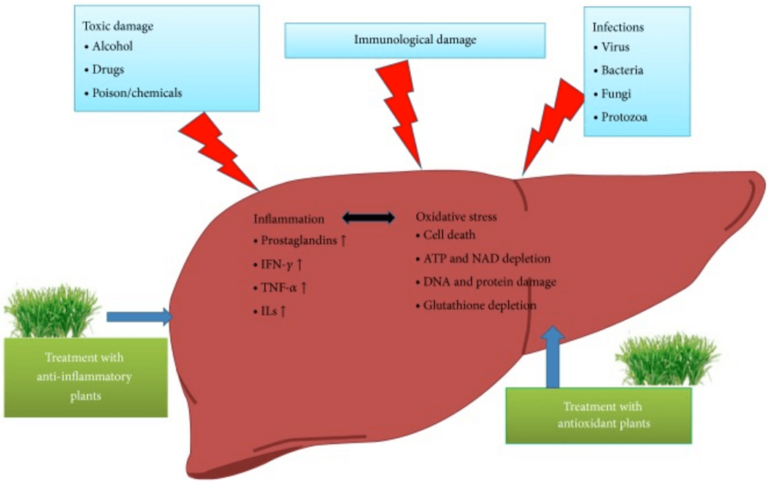
Diagram showing: Anti-inflammatory and anti-oxidant herbs protect the Liver against a variety of toxins and injurious stimuli by restoring the oxidative stress and the related liver damage and inflammation.
The Ultimate Liver DETOX Program
The Best Liver Detox in NZ
Herbal supplements that address the entire digestive system indirectly support the Liver. By clearing undigested, built-up matter from the colon these herbs will reduce the amount of re-circulating waste substances straining the Liver.
The Ultimate Herbal Detox and BodiClenz
The Ultimate Herbal Detox or BodiClenz programs both give the benefits of most of the very effective herbs we have talked about, including Milk thistle, Globe Artichoke, Goldenseal, Dandelion, Wormwood, Turkish Rhubarb, Kiwifruit, and Barley grass. It is the combination of these foods along with the specific foods mentioned above which give you an excellent liver cleansing program.
You should use these programs over 14-days following what’s called the Deep Cleanse Program. Read more about the Deep Cleanse program here
LivaFood Tonic Capsules
Livafood is a nutrient-rich formulation that supports liver function and provides a broad range of naturally occurring nutrients including superoxide dismutase which supports phase 2 liver detoxification plus 700mg of Milk Thistle herb per capsule. The addition of Cilantro and Chlorella promotes the process of a heavy metal detox, helping to remove lead and mercury.
Ingredients: Barley grass (Hordeum vulgare), Globe Artichoke (Cynara scolymos) root, Dandelion (Taraxacum officinale) root, Cilantro (Coriandrum sativum), Chlorella (Chlorella Vulgaris), Golden Seal (Hydrastis canadensis) root, Milk thistle (Silybum marianum) seed.
Take 4 capsules daily for one month directly after completing the Ultimate Herbal Detox or BodiClenz 14-day Deep Cleanse.
LiverClenz Liquid Tonic
LiverClenz Liquid Tonic contains a blend of classic liver tonic herbs formulated by Brett Elliott, Medical Herbalist.
The formula includes the following herbs: LIcorice, Milk thistle, Dandelion, Bupleurum, Andrographis, Gentian, Goldenseal, Hops.
Take 10ml three times daily alongside the 14-day Deep cleanse program
LiverClenz The Ultimate Herbal Detox Combo Program
Get all of the above products in one complete package for a full 6 week Liver detox program. This combo deal is discounted by 20%
Understanding Liver Energy
In Traditional Chinese Medicine (TCM) the Liver is known as the Seat of Anger The Liver organ system reflects the condition of the nails and muscle sinews and expresses itself in emotions such as anger or sadness. When emotion is overwhelmingly excessive, no medicinals can cure the resulting disorder. It must be overcome by emotion. Thus it is said that anger damages the Liver system (25)
For example, when a patient presents with prolonged grief and depression after the death of a loved one, a discussion may allow the patient to identify anger as an underlying emotion—anger that the person left them. From a TCM perspective, anger results in Liver disharmony, which frequently manifests as depression. The anger needs to be cleared in order to lift the depression. (24)
Most bitter herbs we talked about above are cooling and calming to the Liver as are some foods such as fresh greens, cider vinegar, and lemon juice in water.
A study published in the Journal of Hepatology found that patients with chronic liver disease exhibited a higher prevalence of peripheral neuropathy, including symptoms like burning feet. (37)
Cirrhosis, a severe form of liver disease characterized by scarring and impaired liver function, can lead to venous congestion and edema in the lower extremities. This can cause discomfort and sensations like burning feet.
Detox Your Liver For Better Health Results
Finding peace is very important to healing the Liver, so seeking downtime and the space to release those feelings will be important. Cathartic exercises like cycling, rowing, boxing, or running will also be helpful. Even just a regular walk by the trees or ocean will help.
You will see very noticeable differences in your health when you pay attention to the foods and herbs that benefit your Liver. Doing a regular detox for the colon with additional herbs to support your Liver will reward you with faster initial results and ongoing improvement as you continue to eat healthy, living foods.
It is good to get a combination of these foods and ingredients into your regular routine but high doses in the short term could promote rapid detoxification and healing by way of quickly restoring healthy Liver function.
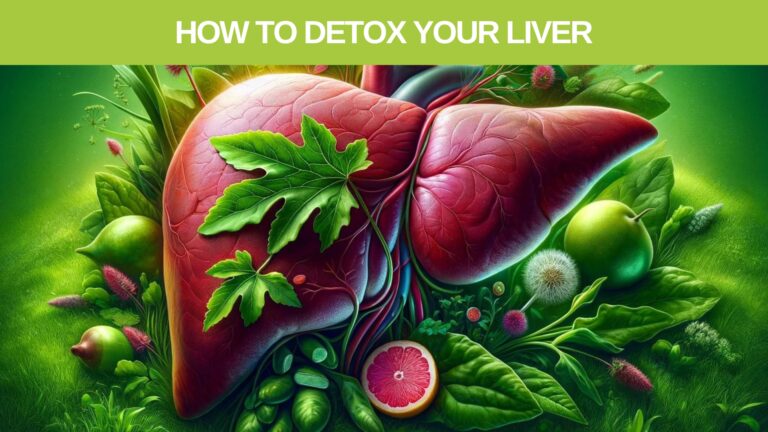
Conclusion
The benefits of performing a natural Liver detox with supplements are wide-ranging and include increased energy, mental clarity, improved blood sugar, cholesterol balance, reduced headaches, allergies, and better digestion.
By introducing the most beneficial Liver cleansing foods into your diet along with the Liver supporting herbs above which form part of a Herbal DETOX you can quickly and effectively support your Liver and improve your general health.
Brett Elliott ®

